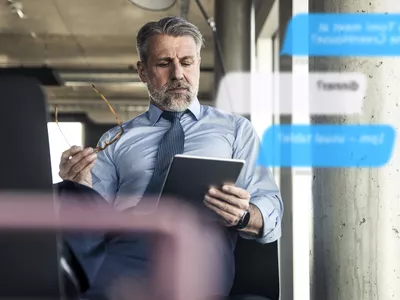
In 2024, Easy Methods How To Transfer Pictures From Apple iPhone 14 Pro to PC | Dr.fone

Easy Methods: How To Transfer Pictures From Apple iPhone 14 Pro to PC
Photo transfer from your iPhone to your PC is a common practice for various reasons. It can free up your device’s storage space, create backups, or simply edit and organize your photos on a larger screen.
Thankfully, there are various methods to transfer pictures from your iPhone to your PC, providing flexibility to users based on their preferences and convenience. Read our comprehensive guide on how to transfer pictures from Apple iPhone 14 Pro to PC. This article covers step-by-step instructions so you can easily and efficiently manage and transfer your iPhone photos to your computer while preserving your cherished memories.
Part 1: How To Transfer Pictures From Apple iPhone 14 Pro to PC with iCloud
One of the widely used and efficient methods to transfer pictures from your iPhone to a PC is through iCloud, Apple’s cloud-based service. iCloud provides seamless integration across Apple devices, allowing users to sync and access their photos and videos effortlessly.
However, even if your PC is using other operating systems, such as Windows, you can still use iCloud for Windows to save and transfer your iPhone photos from iCloud.
How to transfer iPhone photos to a computer using iCloud:
Step 1: Make sure you have synced iCloud photos on your iPhone.
On your iPhone Settings, go to your profile and tap iCloud. Then, select Photos and turn on the switch next to “Sync this [device].” Otherwise, go to iCloud settings > iCloud Drive, and switch on “Sync this iPhone.”
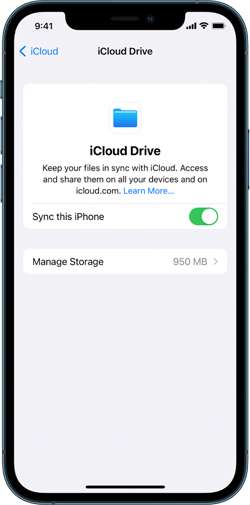
Step 2: Set up your iCloud for Windows.
Open iCloud for Windows and ensure you’re signed in with your Apple ID. Next to Photos, select Options > iCloud Photos. Click “Done” and “Apply” to save the changes and close the window.
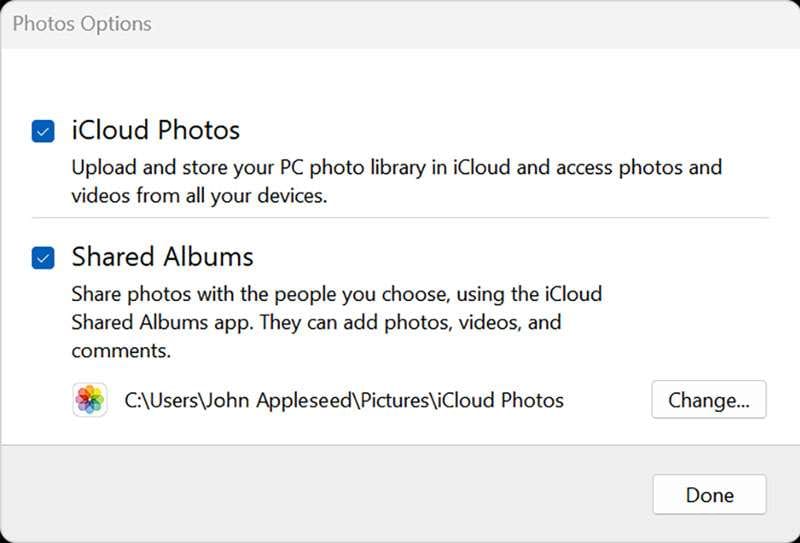
Step 3: Keep iPhone photos on PC.
Open iCloud Photos and select the images you want to transfer to your PC. Right-click to open a drop-down menu and choose “Always keep on this device.”
That’s it! Now, you can find your iPhone Photos on your computer.
Part 2: How To Transfer Pictures From iPhone with Google Drive
Another convenient way to transfer iPhone pics to a computer is through Google Drive. As a cloud-based storage solution, Google Drive allows users to seamlessly store, manage, and share files, including photos, across different devices.
If you already have a Google account, you can jump right into Google Drive without signing up. However, be aware that the free version only gives you 15 GB of space. If you need more room, you’ll have to sign up for a subscription.
How to transfer iPhone pictures to a computer with Google Drive:
Step 1: Set up your Google Drive.
Open Google Drive on your iPhone. Once opened, tap the multicolored + symbol and select “Upload” > “Photos and Videos.” If prompted, grant access to all photos by tapping “Allow Access to All Photos.”
Step 2: Upload your iPhone photos on Google Drive.
Browse through your iPhone albums to locate the specific photos you wish to upload. Hold and tap to select multiple photos. Then, tap “Upload” to upload your iPhone photos to Google Drive.
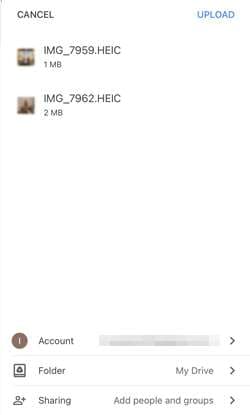
Optional: Automatic backup or sync with Google Photos
For those seeking automatic backups, open Google Photos, tap your profile image, navigate to “Google Photos settings,” and select “Backup & Sync.” Toggle “Backup & Sync” to On for continuous backups.
Step 3: Transfer your iPhone photos from Google Drive to your PC.
Once your photos are stored on Google Drive, proceed to save and transfer them to your PC. Select the desired photos in Google Drive, and click “Download.”
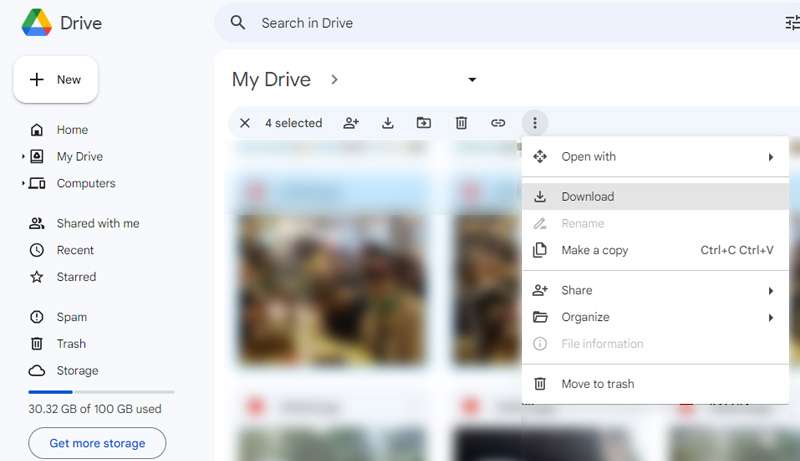
To save all photos from a specific Google Drive folder, open Google Drive and select “My Drive.” Locate the intended folder, and click the three dots to open the drop-down menu. Select “Download,” and all photos and files within the folder will be saved to your computer in ZIP format.
Part 3: How To Transfer Pictures From iPhone with iTunes
You can also make the most of iTunes to secure your iPhone with backups, keep it up-to-date, or synchronize content between your iOS device and your computer in both directions. Even if you’re a Windows PC user, there’s no need to fret. Although iTunes is an Apple product, it’s also available for Windows use.
To get started, make sure that you have iTunes for Windows installed or update your existing version to at least iTunes 12.5.1. Once done, follow the instructions below.
How to transfer iPhone pics to a PC using iTunes:
Step 1: Connect your device to your computer.
Plug in your iPhone to your computer using a USB cable.
Step 2: Grant access to your iPhone Photos.
If your phone is asking you to Trust This Computer, tap “Trust” or “Allow to proceed.”
Step 3: Open your computer’s Photos app.
Go to the Start menu on your PC. Search and select Photos to open the Photos app.
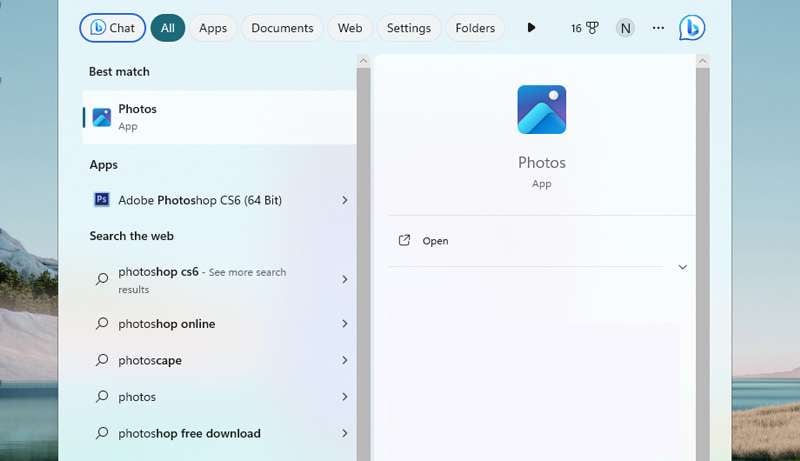
Step 4: Import your Photos to your PC.
Within the Photos app, click on Import > From a USB device and follow the instructions on the screen. You can choose specific photos for the transfer and decide where to save them on your PC. Remember to make sure that the photos are saved on the Apple iPhone 14 Pro device rather than stored in the cloud.
Finally, allow a few moments for the system to detect and transfer the selected photos.
Part 4: How To Quick Transfer Pictures From Apple iPhone 14 Pro to PC
If you find the above methods difficult, there is a quick and easy way to transfer photos from your iPhone to a PC with Dr. Fone’s Export All Data feature. With this feature, there’s no need to navigate through various locations to just locate and transfer files from your iPhone.
Dr.Fone - Phone Manager (iOS)
Transfer Photos from Computer to iPod/iPhone/iPad without iTunes
- Transfer, manage, export/import your music, photos, videos, contacts, SMS, Apps, etc.
- Back up your music, photos, videos, contacts, SMS, Apps, etc., to the computer and restore them easily.
- Transfer music, photos, videos, contacts, messages, etc., from one smartphone to another.
- Transfer media files between iOS devices and iTunes.
- Fully compatible with iOS 7 to iOS 15 and iPod.
3981454 people have downloaded it
Dr. Fone’s Export All Data feature offers some great functionalities, including:
- Comprehensive data export, including Photos, Contacts, Messages, Voicemail, and more
- Encrypted data transfer and backups
- Available for iOS and Android devices
- Regular updates to provide an enhanced user experience
To transfer photos from your iPhone to a PC using Dr.Fone, follow the step-by-step below:
Step 1: Launch Dr.Fone and make device connections using a USB cable.
Start by Image nameing your iPhone device to the computer via a USB connection. Launch Dr.Fone and select “Export all data” in the My Device section.
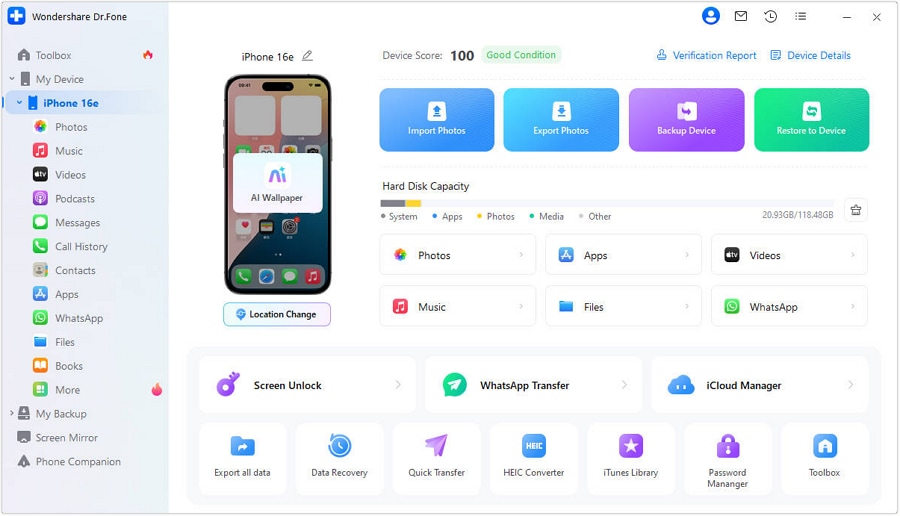
Step 2: Choose file types for export
When a new window appears, select the specific file types you wish to transfer (in this case, your photos). Then, click “Export” at the bottom of the screen to initiate the procedure. Choose the preferred location for saving the exported data.
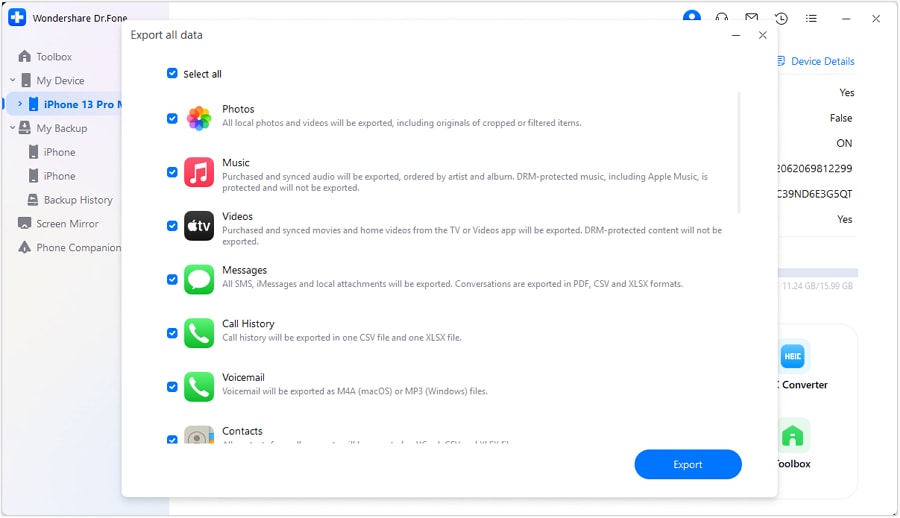
Step 3: Make a password for the backup file
Next, you will be asked to create an encrypted password for the backup file to be stored on the computer. Set a password, confirm it, and click “Done” to execute the process.
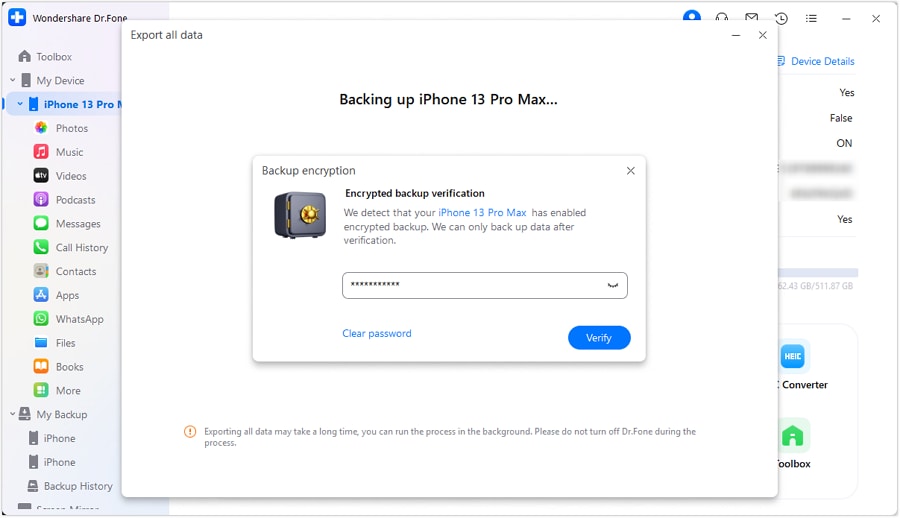
Step 4: Monitor the progress
Your iPhone will start exporting its data to the computer through Dr.Fone. You can wait and monitor the progress on the screen.

Step 5: Successful export of data to the computer
After successful completion of exporting the data, a window will appear on your computer screen. Click “Open” to review the exported data at the specified location.
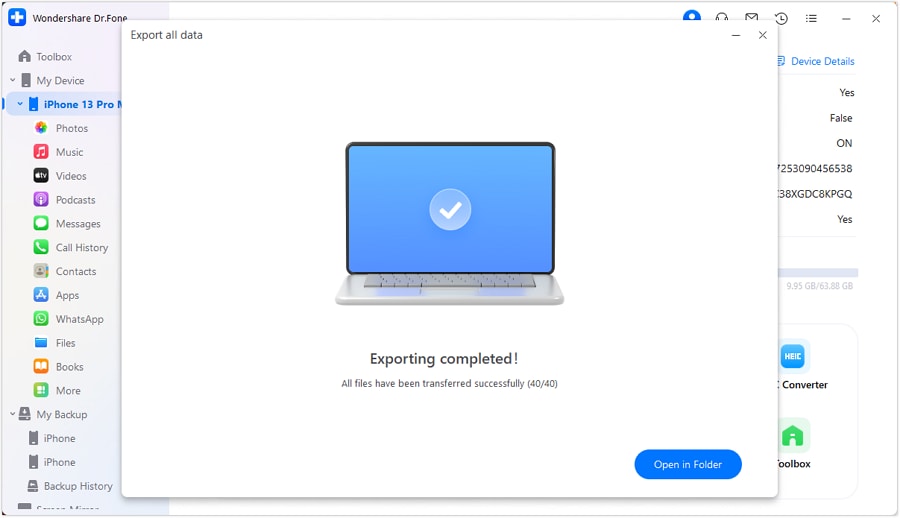
Conclusion
Before, you must have wondered how do you transfer pictures from Apple iPhone 14 Pro to PC. But after learning from the article above, you now have a variety of straightforward methods in your hand, whether with iCloud, Google Drive, iTunes, or reliable software like Dr.Fone.
If you’re embedded in the Apple ecosystem, iCloud provides seamless integration of your iPhone Photos. Alternatively, Google Drive offers a cross-platform solution, enabling you to upload your iPhone photos to the cloud and access them on your computer browser.
For those who prefer a more traditional approach, iTunes provides a straightforward method via a USB connection. And if you’re looking for a quick and versatile third-party solution, software like Dr.Fone simplifies the data transfer process with its user-friendly interface and robust features.
How To Transfer Data from Apple iPhone 14 Pro to New iPhone 15
Upgrading to a new iPhone 15 is always an exciting prospect. However, the thought of transferring all your data from your Apple iPhone 14 Pro to the new iPhone 15 model might seem like a daunting task. Luckily, there is no need to worry, as this guide will resolve all your concerns on how to transfer to the new iPhone 15.
In this detailed article, we explore the process of transferring data from an old iPhone to a new one. Our step-by-step approach will equip you with the knowledge to move your valuable data.
Part 1: Why Should You Shift From Your Apple iPhone 14 Pro to iPhone 15?
In the realm of smartphones, change is not just inevitable; it’s a constant. With the unveiling of the iPhone 15, Apple once again beckons users to take a leap forward. However, you might be wondering why you should bid farewell to your Apple iPhone 14 Pro . The answer lies in the myriad of improvements and features that the iPhone 15 brings to the table. Some of these are summarized below:
1. Cutting-Edge Technology
The iPhone 15 is an example of Apple’s commitment to pushing the boundaries of technology. It offers advancements in processing power, camera capabilities, and display technology. This new iPhone promises to redefine what a smartphone can do.
2. Enhanced Camera Systems
For photography fans, the iPhone 15’s camera system is nothing short of revolutionary. From improved low-light performance to detailed zoom capabilities, it reaches a whole new level of quality.
3. Seamless Connectivity
The new iPhone 15 comes integrated with 5G technology. This ensures that you’ll be at the forefront of high-speed connectivity. You can say goodbye to buffering and lag because iPhone 15 promises smoother streaming, faster downloads, and a more responsive online experience.
4. Extended Software Support
With every new iPhone iteration, Apple launches its latest iOS firmware. Upgrading to the iPhone 15 means enjoying the latest iOS 17 updates. It also means getting security enhancements for years to come.
Part 2: How To Transfer Apple iPhone 14 Pro iCloud Backup to iPhone 15?
Transitioning to the new iPhone 15 is an exciting experience. It means you need to ensure that your data seamlessly makes the journey to the new iPhone 15. Apple provides a convenient way to transfer your data in the form of iCloud. You can create an iCloud backup of your old device and restore it to the new one. Use the following guide to transfer to iPhone 15 with iCloud:
- Step 1: On your Apple iPhone 14 Pro , navigate to “Settings,” tap on your Apple ID, select “iCloud,” and then “iCloud Backup.” Here tap “Back Up Now” to create an iCloud back of your iPhone data.
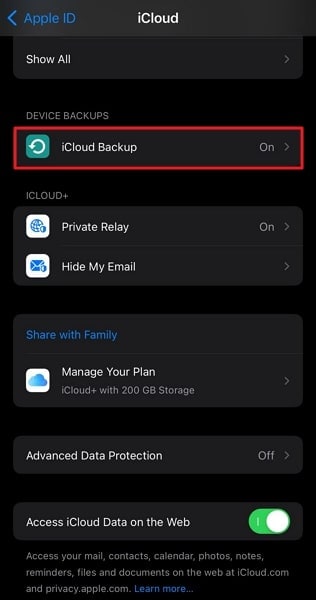
- Step 2: Power on your iPhone 15 and follow the setup prompts until you reach the “Apps & Data” screen. Then, proceed with the “Restore from iCloud Backup” feature and sign in using your Apple ID credentials.
- Step 3: A list of available iCloud backups will appear on the screen. Here you need to select the most recent backup from your Apple iPhone 14 Pro . Keep in mind that a reliable Wi-Fi connection is essential for a smooth and speedy transfer.
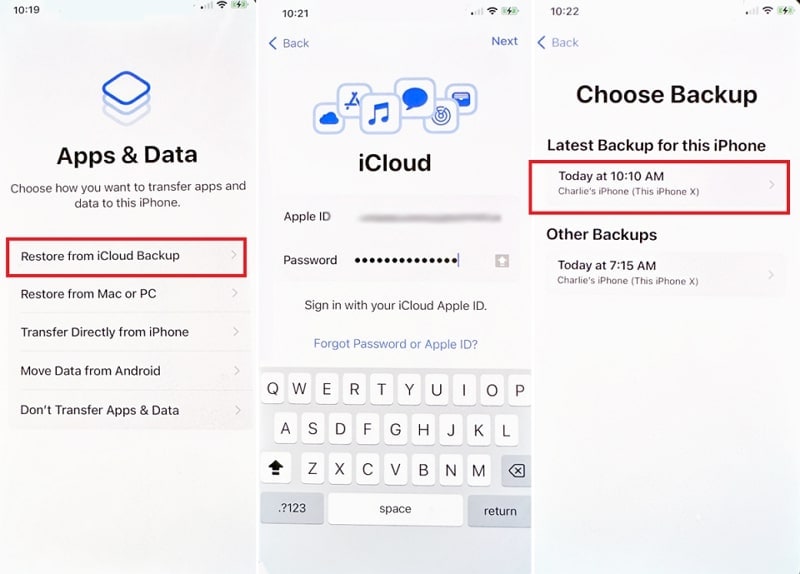
Part 3: How To Transfer Apple iPhone 14 Pro Data Directly to iPhone 15?
While iCloud offers a seamless way to transfer data, some users prefer a more direct approach. It is especially if internet connectivity is limited or they want to hurry the process. Luckily, Apple provides a method to transfer data directly from your Apple iPhone 14 Pro to the new one. It is commonly referred to as the “Quick Start” method, and you can use it by following these steps:
- Step 1: Before initiating the transfer, ensure that your Apple iPhone 14 Pro is on the latest version of iOS. You will also need to turn on Bluetooth and Wi-Fi on the old iPhone. Power on both your Apple iPhone 14 Pro and your new iPhone 15 and place them side by side.
- Step 2: A pop-up will appear on your Apple iPhone 14 Pro , asking if you want to use your Apple ID to set up your new device. Confirm this action by tapping “Continue.” Your iPhone 15 will generate dynamic animation, which the old iPhone needs to capture through its camera.
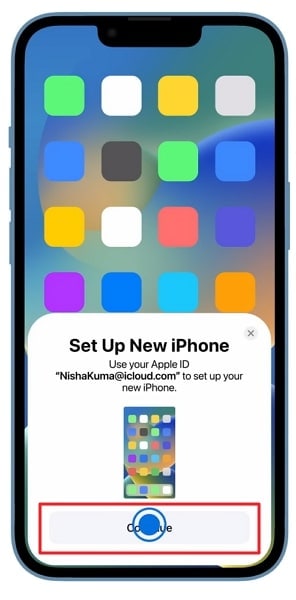
- Step 3: This animation contains security information and establishes a connection between devices. On the new iPhone, you will be required to provide the old phone passcode. Enter the passcode and log in using your Apple ID. Subsequently, select “Transfer from iPhone” and patiently await the process to finish.
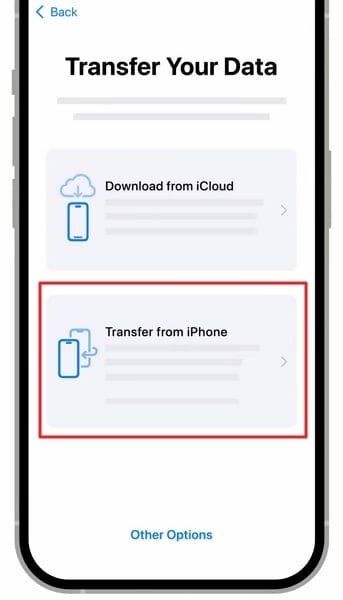
Part 4: How To Transfer Apple iPhone 14 Pro iTunes/Finder Backup to iPhone 15?
Looking for a more hands-on approach to data transfer? Using iTunes/Finder can be an effective way in this scenario. It is a recommended way if you have larger backups stored on your computer. To migrate your data from an old iPhone to the new iPhone 15 with iTunes/Finder, you can use the following steps:
- Step 1: Make sure you have the latest version of iTunes/Finder installed on your computer. First, connect your Apple iPhone 14 Pro to the computer and create a backup through the “Summary/General” tab. After the backup has finished, proceed to disconnect the old iPhone.
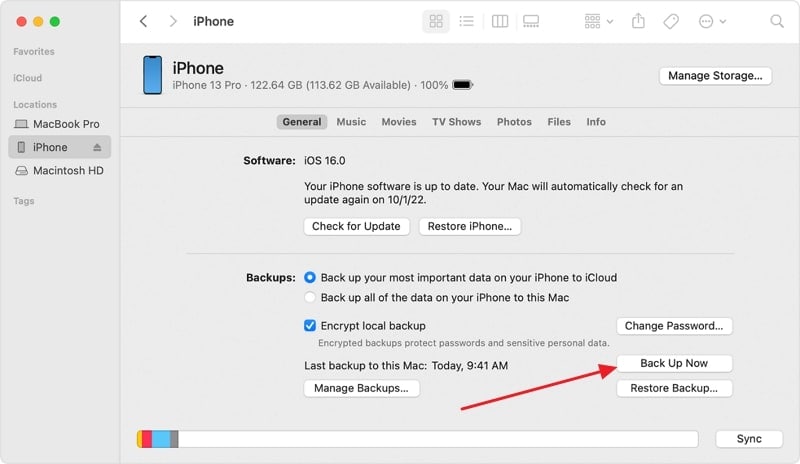
- Step 2: Now start setting up the new iPhone 15 and navigate to the “Apps & Data” screen. Here, choose “Restore from Mac or PC” and connect the Apple iPhone 14 Pro device to the computer or MacBook with backup.
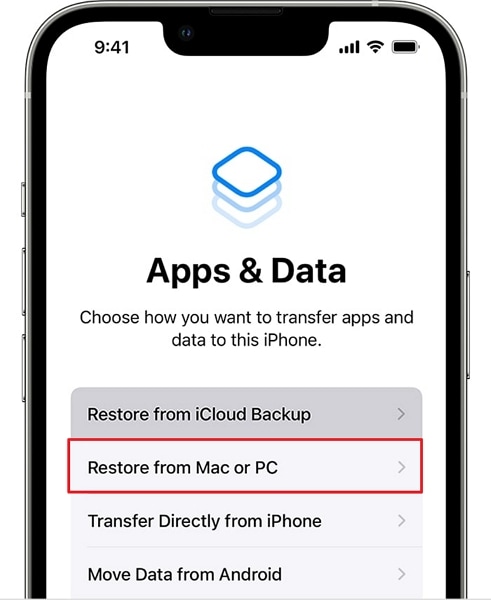
- Step 3: Launch iTunes/Finder on the computer after trusting the Apple iPhone 14 Pro device and tap the “Device” icon. Then, from the “Welcome to Your New iPhone” screen, enable the “Restore from this backup” option and choose your Apple iPhone 14 Pro backup file. Afterward, press the “Continue” button to restore the old iPhone backup to your iPhone 15.

Bonus Tips: Having Trouble When Transferring to iPhone 15 Stucks?
The issue of iPhone 15 getting stuck when users attempt to transfer data from their older devices, like the iPhone 14, to the new iPhone 15 has become a frustrating challenge for many Apple enthusiasts. This problem often arises due to the complex nature of data migration and the high expectations associated with Apple’s seamless ecosystem. When attempting to transfer photos, apps, contacts, and other vital information, users may encounter lengthy delays, frozen screens, or failed transfers.
The possible reasons could be:
- ·Software glitches
- ·Insufficient storage space
- ·Incompatible iOS versions between the old and new devices
The impact of this issue extends beyond mere inconvenience, as it can result in data loss or a less-than-optimal out-of-the-box experience with the latest iPhone. Addressing this problem, you may try:
- ·Updating both devices to the latest iOS version
- ·Ensuring sufficient storage
- ·Seeking assistance from Apple Support
- ·Authorized service providers when necessary
Or, you can also try to ask for help from a third-party application, Dr.Fone - Phone Transfer is always at your service. Dr.Fone - Phone Transfer offers a reliable solution to the iPhone data transfer problem. This user-friendly software is designed to simplify the migration process, making it hassle-free for iPhone users. Here are the steps to get you started:
Step 1 Launch Phone Transfer Tool
Initiate the process by launching Wondershare Dr.Fone on the computer. Continue from Toolbox > Phone Transfer to redirect towards opening the particular tool.

Step 2 Set Data Transfer Path
On accessing the Phone Transfer tool, continue to connect your iOS devices and let them load their data on the next screen. Here, define the Source and Destination of the transfer to specify the direction of the phone transfer. To change locations, use the Flip button on the top.

Step 3 Choose Data Types
After successfully determining the source and destination, select the specific data types you want to transfer. Checkmark all data and select Start Transfer to proceed with the operations.
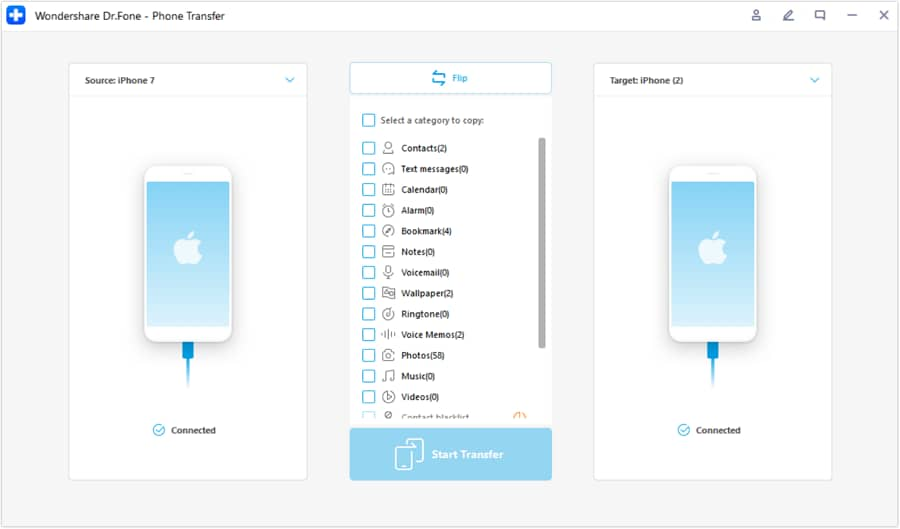
Step 4 Turn Off Find My Feature
Once done, a prompt appears on the front asking to turn off the Find My feature on iOS devices. Open the Settings of the iOS device and proceed further by tapping on the name at the top. Continue from iCloud > Find My feature and turn it off.
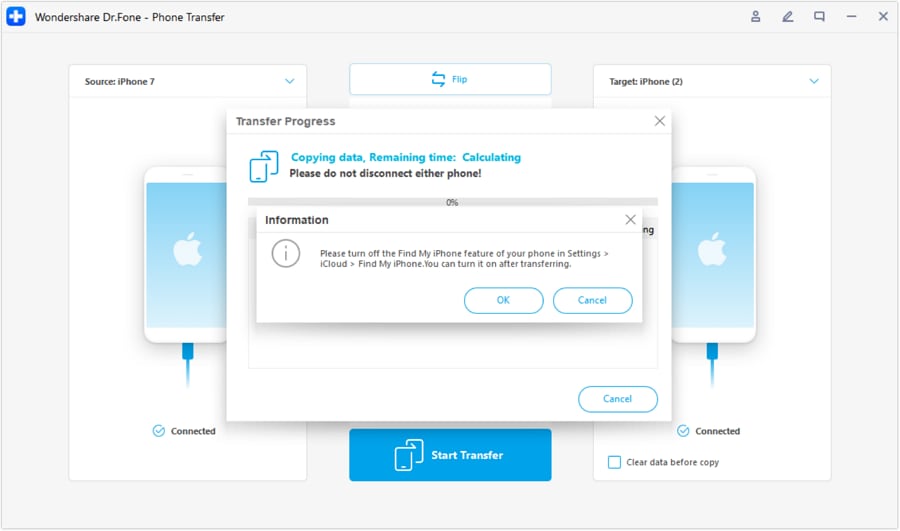
Step 5 Complete Your Transfer
Once done, the window in the front shows the completed phone transfer. Click OK to conclude the process entirely.
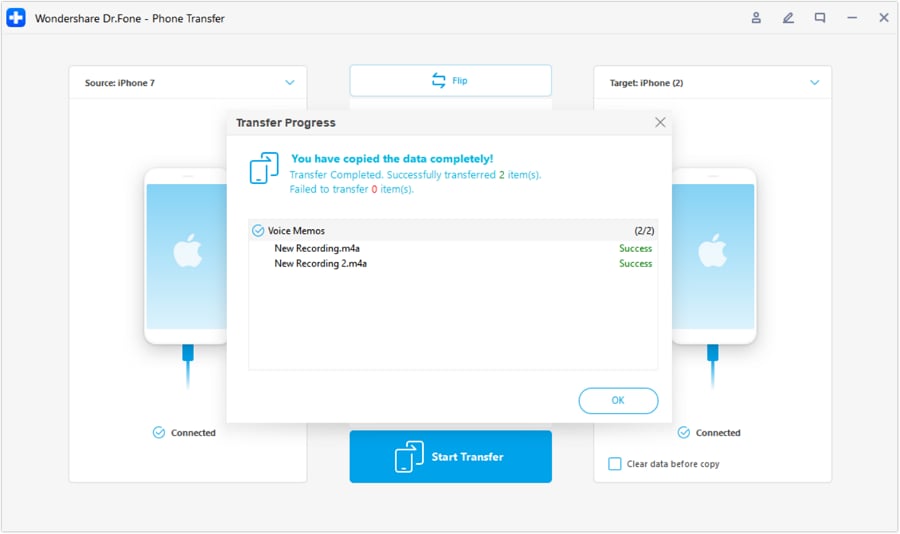
Conclusion
In summary, we’ve explored various methods to iPhone 15 transfer data. These ranged from iCloud to direct device-to-device transfers and iTunes/Finder. Each method offers its own advantages, catering to different preferences and circumstances.
However, one solution that truly stands out for its speed, ease, and efficiency is Wondershare Dr.Fone. It provides a fast and direct solution for transferring your data between your Apple iPhone 14 Pro and the iPhone 15.
Should I Switch From iPhone To Google Pixel?
The battle between smartphone giants has been a consistent source of intrigue for consumers. Through every new launch, tech giants such as Apple and Google introduce impressive functions. These allure users with the prospect of improved efficiency and seamless usability. This prompts the fundamental query of whether one should consider switching from an iPhone to a Pixel.
Amid the ongoing discourse about these two devices, it becomes imperative to go through the advantages and disadvantages inherent to each. This serves to equip you with the necessary insights for making a choice that aligns with your preferences. In this guide, we will explore the key considerations to contemplate when switching from an iPhone to a Google Pixel.
Part 1: What Is The Google Pixel?
An Android smartphone launched by Google in 2016, Google Pixel was designed to replace the Nexus. Similar to Nexus, the Pixel operates a “stock version” of Android, which means that it gets updates as soon as they’re released. Other Android smartphones sometimes delay updates for weeks or even months. The Google Pixel comes with free unlimited photo storage on Google Photos. Additionally, Google Photos for the Pixel doesn’t compromise the photo quality in order to save room. Well, there is much more to explore about Google Pixel.
Key Specifications-
- OS- Android 7.1 and upgradable to Android 10.
- Internal Memory - 32GB 4GB RAM, 128GB 4GB RAM
- Main Camera - 12.3 MP & Selfie Camera - 8 MP.
- Premium design with fingerprint sensors
- Headphone Jack & USB Type -C
- Larger and crisper display
Let’s first have a quick look at all versions of it:
- Google Pixel & Google Pixel XL- Launched in 2016, these come with a circular icon theme and offer free unlimited full-quality photo storage.
- **Google Pixel 2 & Google Pixel 2XL -**The 2nd generation Google Pixel was launched in 2017. The XL version contains very slim bezels, like iPhone X smartphones. It even facilitates a far better camera in comparison to its competitors.
- Google Pixel 3 & Google Pixel 3 XL - Launched in 2018, Google Pixel 3 followed the trends of the first two phones. Enhancements to the display, screen, and camera were made and other improvements as well. The Pixel 3 XL even has entails a top-notch, like the iPhone X. However, you have the choice to remove the notch by disabling the display at the top. It also comes with a wireless charging feature.
- Google Pixel 3a & Google Pixel 3a XL - They are less expensive versions of the 3 and 3 XL. The notable difference is that 3a entails a single selfie camera, whereas 3 has a dual selfie camera.
- Google Pixel 4 & Google Pixel 4 XL - Launched in 2019, the fourth generation drastically enhanced face unlock. A 3rd rear-facing camera was introduced to the Apple iPhone 14 Pro device. On the phone’s front, the notch was substituted by a standard top bezel.
- Google Pixel 4a & Pixel 4a 5G - Released in 2020, the Pixel 4a was a more affordable variant that retained many features from its predecessor. It offered a compact design, a single impressive rear camera, and the latest Android software. The Pixel 4a 5G shared similarities with the Pixel 4a but introduced 5G connectivity and a larger display.
- Google Pixel 5 & Pixel 5a 5G - The Pixel 5, released in 2020, focused on a balance of performance and price. It featured a mid-range Snapdragon processor, 5G capability, and an improved camera system. The Pixel 5a 5G, introduced in 2021, continued the legacy of affordable yet capable Pixel devices, enhancing the camera and offering 5G connectivity.
- Google Pixel 6, Pixel 6 Pro & Pixel 6a - Launched in 2021, the Pixel 6 series marked a significant departure in design and hardware for Google. The devices featured Google’s custom Tensor chip, aiming for enhanced AI capabilities. The Pixel 6 Pro boasted a larger, higher-resolution display and additional camera features than the standard Pixel 6 model. Both phones focused on camera advancements, software enhancements, and unique design aesthetics. The Pixel 6a continued to be the affordable version of the Google Pixel 6 series.
- Google Pixel 7, Pixel 7 Pro & Pixel 7a - Arrived in 2022, the Google Pixel 7 series came equipped with Google’s 5nm Tensor G2 chip and powerful 50MP camera. It also boasts 8 GB of RAM and a long-lasting battery. The Pixel 7 Pro is the higher-end product of the series. It has additional camera enhancements and more RAM or storage options. The Pixel 7a is a more affordable variant with some compromises in hardware specifications compared to the higher-end models.
- Google Pixel 8 & Pixel 8 Pro - Running on a Powerful 4nm Google Tensor G3 chip, Google Pixel 8 and Pixel 8 Pro are the latest devices in the Pixel series. The RAM has increased in these devices, with the Pixel 8 boasting 8 GB RAM and 12 GB for Pixel 8 Pro.
Considering key specifications and features, it is definitely worth switching from Apple iPhone 14 Pro to Pixel, especially if it has been a long time since you’ve been using an Apple device.
Part 2: Notice That You Should Know Before Switching from iPhone To Google Pixel
Before you switch iPhone to Pixel 2, there are certain things to consider or you need to do, so let’s have a look at them-
1- Disable iMessage
When messaging other iPhones from your iDevice, they’ll communicate through iMessage when you connect to the internet. That’s different from usual SMS texting. And if you leave iMessage switched on your iPhone, many of your messages will be routed via that service. If you’re on a new Google Pixel smartphone, you won’t get any of those texts. Thus, you need to turn off iMessage before you make that switch. While you’re here, disable FaceTime.

2- You Might Need to Buy Your Apps Again
Have you pay-front apps on your iDevice that you paid for? If so, then you’ll probably need to purchase them again from the Google Play Store if you want those apps on your Google Pixel phone as well. The App Store and Google Play Store are entirely different entities and the housed apps are designed for different platforms. Some apps you had on your iDevice may not even be accessible for your Google Pixel device and vice-versa. However, if you’ve subscribed to a service such as Spotify, you just have to get the app and sign in to your new Android device and that’s it.
3- Re-Sync Your Crucial Data
If you have all of your calendar events, contacts, documents, and photos synced with iCloud and all is on your iPhone, you’ll probably need to re-sync all on your Google Pixel device. Android’s cloud version is housed in Google apps such as Gmail, Contacts, Docs, Drive, etc. When you set up your Google Pixel, you’ll create and set up a Google account. From this point, you can sync some of the iCloud content with the Google account, thus you won’t need to re-enter lots of info.
4- Back up Photos to Transfer them from Apple iPhone 14 Pro to Google Pixel with Ease
The easiest way to transfer your pictures from your iPhone to Google Pixel is to use the Google Photos app for iPhone. Log in with your Google account, click the backup and sync option from the menu, and then, get Google Photos on your Google Pixel and log in.
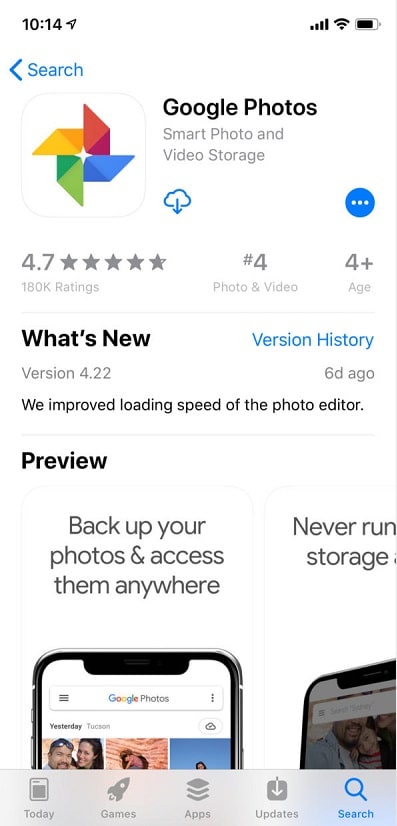
5- Back Up Your iPhone Data to Avoid Data Loss
1. Using iCloud Backup
To begin, link your iPhone to a Wi-Fi network. Then, navigate to the Settings app and tap on your name, followed by selecting “iCloud.” Scroll down within the options and locate “iCloud Backup.” Switch on the “iCloud Backup” option and proceed to tap “Back Up Now” to immediately initiate the backup process. Make sure to verify that the backup is fully completed before moving forward.
![]()
2. Using iTunes on a Computer
Begin by linking your iPhone to a computer using a USB cable. Launch iTunes and pick your device from the list. Navigate to the “Summary” segment and opt for the “Back Up Now” selection. This action will generate a comprehensive backup of all your iPhone data on the computer.
![]()
3. Wondershare Dr.Fone

Wondershare Dr.Fone
One click to back up your iPhone data!
- One-click to back up the whole iOS device to your computer.
- Allow previewing and selectively export from Apple iPhone 14 Pro to your computer.
- No data loss on devices during the restoration.
- Works for all iOS devices. Compatible with the latest iOS version.

3981454 people have downloaded it
The most advanced and reliable phone backup toolkit is Wondershare Dr.Fone because it helps you back up data without worrying about storage space. It also provides the Incremental feature through which your iPhone is backed up without connecting to the computer.
Furthermore, you can preview data stored in your iPhone backup file and restore specific data to your iDevice. It can also restore your iCloud/iTunes backup to your iPhone/Google Pixel without factory resetting the Apple iPhone 14 Pro device.
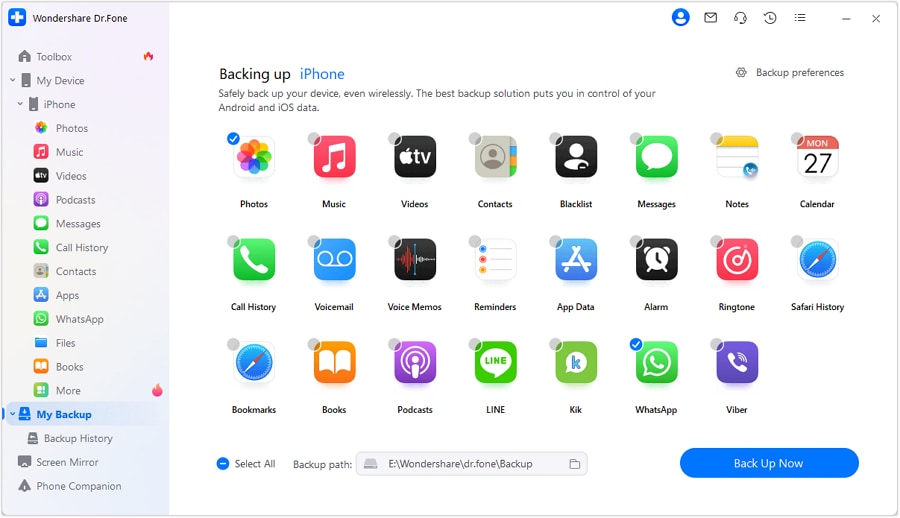
Part 3: How Many Data Can I Email To Google Pixel?
Thinking about transferring data from Apple iPhone 14 Pro to Google Pixel by Email? Well, it is the best option only if you want to transfer small-size files and not much data. And yes, there is a limit to how many or much data can you email to your new Google Pixel device.
The email size limit is 20 MB for some platforms and 25 megabytes for others. For instance, if you want to send a video from your iPhone to your new Google Pixel device, then the video should be less than 15 or 20 seconds long to share via email.
Part 4: One-Stop Solution to Switch Data From iPhone To Google Pixel
If you want a one-stop solution to transfer data from Apple iPhone 14 Pro to Google Pixel, then you need to rely on a powerful phone-to-phone data transfer software like Dr.Fone - Phone Transfer . With its assistance, you can transfer contacts both in a cloud account and phone memory along with videos, photos, text messages, etc from Apple iPhone 14 Pro to Google Pixel in just one click.
To help you learn how to use Dr.Fone - Phone Transfer program for switching iPhone to Google Pixel 3, below is the simple guide-
Step 1: Get the Dr.Fone - Phone Transfer on your computer and then run it. Then, choose the “Phone Transfer” option.

Step 2: After that, connect both of your devices to the computer and let the software detect them. And ensure that iPhone is selected as a source and Google Pixel as the target and select the files you want to transfer.
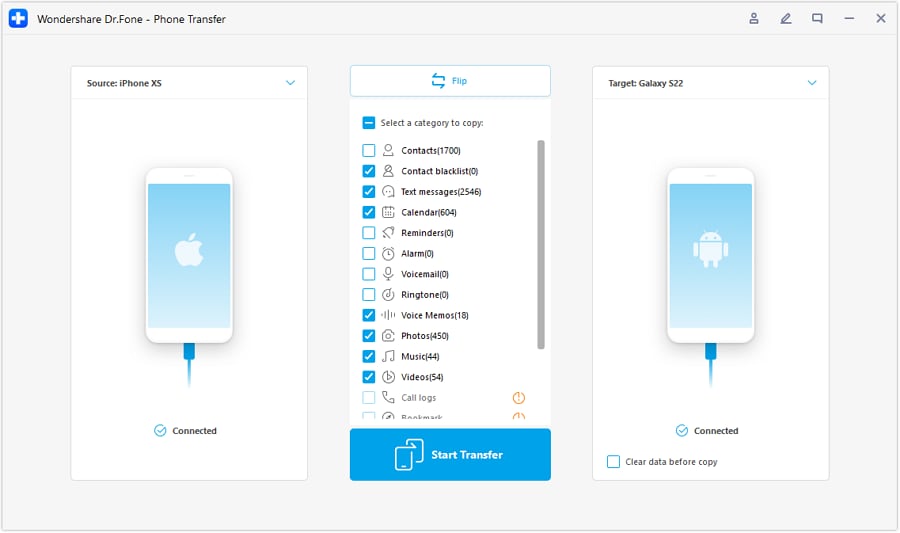
Step 3: Finally, hit the “Start Transfer” button to begin the transfer and that’s it.
And if you ever want to get back to your iPhone, then you would probably wonder how to switch from Pixel to iPhone. In that case, all you need is a phone-to-phone data transfer app like Dr.Fone - Phone Transfer to make the switch successful with all the data you need on your new device.
The Bottom Line
Switching between the iPhone and Google Pixel demands thoughtful deliberation, as evidenced by the ongoing debate. Factors like OS preferences, app compatibility, and data synchronization need to be considered. While the transition process may seem daunting, many tools can simplify the switch. They ensure a smooth experience of switching from Apple iPhone 14 Pro to Google Pixel.
In this context, Wondershare Dr.Fone emerges as a comprehensive and user-friendly solution. It helps you in transferring data from an iPhone to a Google Pixel. With its versatile data transfer capabilities and emphasis on data security, Dr.Fone offers a reliable and efficient data transfer method.
Also read:
- [New] 2024 Approved Enhancing Video Visibility to Attract Vimeo's Top Choices
- Before You Invest: The 5 Key Questions Every Fitness Enthusiast Should Ask About Trackers
- Best Anti Tracker Software For Infinix Hot 40 Pro | Dr.fone
- How to get the dragon scale and evolution-enabled pokemon On Xiaomi Civi 3 Disney 100th Anniversary Edition? | Dr.fone
- How To Restore a Bricked Vivo Y100t Back to Operation | Dr.fone
- How to Transfer Apple iPhone 15 Pro Max Data to iPhone 12 A Complete Guide | Dr.fone
- How to Transfer Data from Apple iPhone XR to ZTE Phones | Dr.fone
- How To Transfer Messages From Apple iPhone 15 Pro to other iPhone All iOS Versions | Dr.fone
- In 2024, 4 Quick Ways to Transfer Contacts from Apple iPhone 13 Pro to iPhone With/Without iTunes | Dr.fone
- In 2024, Best Solutions for Honor Network Unlock
- In 2024, Easy Methods How To Transfer Pictures From Apple iPhone 11 Pro to PC | Dr.fone
- In 2024, Fix Apple iPhone XR Stuck on Data Transfer Verified Solution! | Dr.fone
- In 2024, How To Teleport Your GPS Location On Honor 90 Pro? | Dr.fone
- In 2024, How To Transfer Data from Apple iPhone 11 to New iPhone 15 | Dr.fone
- In 2024, How to Transfer Everything from Apple iPhone 7 to iPhone | Dr.fone
- In 2024, Where Is the Best Place to Catch Dratini On Realme C51 | Dr.fone
- New 2024 Approved A Guide on Starting Private Live Streams on YouTube
- Refurbished Apple iPhone 11 Pro Max Everything You Need to Know | Dr.fone
- The Insider’s Guide to Instagram's Music Licensing Policies for 2024
- Title: In 2024, Easy Methods How To Transfer Pictures From Apple iPhone 14 Pro to PC | Dr.fone
- Author: Charlotte
- Created at : 2024-10-04 22:33:22
- Updated at : 2024-10-11 22:28:26
- Link: https://iphone-transfer.techidaily.com/in-2024-easy-methods-how-to-transfer-pictures-from-apple-iphone-14-pro-to-pc-drfone-by-drfone-transfer-from-ios/
- License: This work is licensed under CC BY-NC-SA 4.0.
